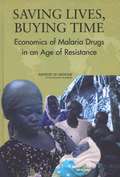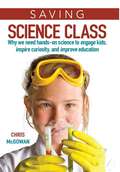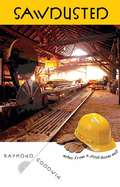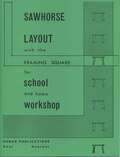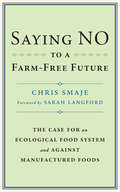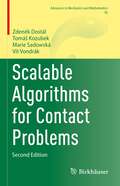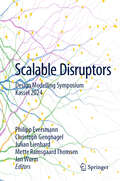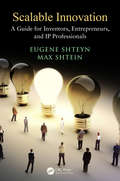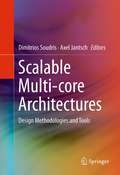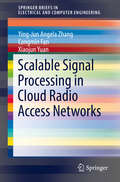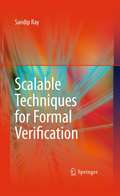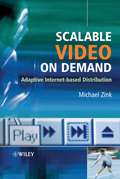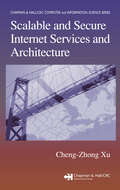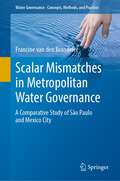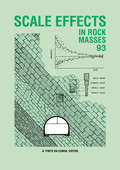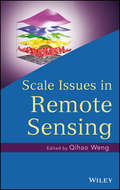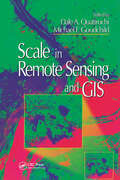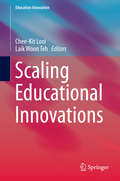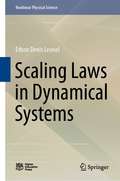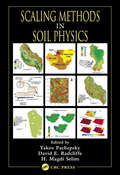- Table View
- List View
Saving Lives, Buying Time: Economics of Malaria Drugs in an Age of Resistance
by Institute of Medicine of the National AcademiesFor more than 50 years, low-cost antimalarial drugs silently saved millions of lives and cured billions of debilitating infections. Today, however, these drugs no longer work against the deadliest form of malaria that exists throughout the world. Malaria deaths in sub-Saharan Africa—currently just over one million per year—are rising because of increased resistance to the old, inexpensive drugs. Although effective new drugs called “artemisinins” are available, they are unaffordable for the majority of the affected population, even at a cost of one dollar per course. Saving Lives, Buying Time: Economics of Malaria Drugs in an Age of Resistance examines the history of malaria treatments, provides an overview of the current drug crisis, and offers recommendations on maximizing access to and effectiveness of antimalarial drugs. The book finds that most people in endemic countries will not have access to currently effective combination treatments, which should include an artemisinin, without financing from the global community. Without funding for effective treatment, malaria mortality could double over the next 10 to 20 years and transmission will intensify.
Saving Science Class: Why We Need Hands-on Science to Engage Kids, Inspire Curiosity, and Improve Education
by Christopher McGowanMuch of what our students are learning about science in school bears little resemblance to real science. That is the main theme of this critique of science education by a veteran scientist and former school teacher. The author charges that today's teaching mandate has been taken over by educational specialists, people with little or no understanding of science. They clutter curricula with extraneous material, like engineering and technology, and focus so much attention theorizing over hypotheses and models and categorizing everything, that no time remains for doing science. There is little to entice youngsters to the science classroom today. McGowan emphasizes that the problem is not the teachers but the materials they are obliged to teach. He is especially critical of the widely influential "Next Generation Science Standards" (NGSS). This is based upon "A Framework for K-12 Science Education," which has been inordinately influenced by educational specialists. This is evident from the esoteric language, the almost exclusive citation of educational publications, and by glaring errors in science. The author urges a rethinking of science education to bring the focus back to conducting real hands-on science in the classroom. This approach was pioneered by the Nuffield Science Teaching Project in the UK, where working scientists acted as resource personnel for teachers designing curricula. Given the catastrophic problems facing planet Earth, scientific literacy has never been more important.
Saving the Starry Night: Light Pollution and Its Effects on Science, Culture and Nature
by Patrizia CaraveoThis book takes a close look at our relationship with the sky, the stars, light and darkness. In particular, it examines how light pollution has interfered with the culture of astronomy and our ability to appreciate this essential facet of our natural world. The sky has always held significance for humanity, in both cultural and scientific terms. And yet we persistently pollute it with (sometimes unnecessary) light in our obsessive desire to chase away the darkness. This effectively switches off the stars, hampering our ability to enjoy one of the most inspiring sights nature has to offer to humankind. In addition, too much light is hazardous to both our health and that of the fauna and flora of this planet. This book also features a comprehensive look at the current controversy regarding efforts to expand internet access through the launch into low Earth orbits of thousands of new satellites, which will pollute the night with moving lights while filling to saturation the capability of the circumterrestrial space. This conflict does not mean that the interests of astronomy and those of space technology have to be at odds, and potential compromises are explored between the satellite initiative and the desire to maintain a dark, radio silent sky.
Sawdusted: Notes from a Post-Boom Mill
by Raymond GoodwinWhen Raymond Goodwin started work at a Michigan sawmill in 1979, the glory days of lumbering were long gone. But the industry still had a faded glow that, for a while, held him there. InSawdustedGoodwin wipes the dust off his memories of the rundown, nonunion mill where he toiled for twenty months as a two-time college dropout. Spare, evocative character sketches bring to life the personalities of his fellow millworkers-their raucous pranks, ribbing, complaints about wages and weather, macho posturing, failed romances, and fantasies of escape. The result is a mostly funny, sometimes heartbreaking portrait of life in the lumbering industry a century after its heyday. Amidst the intermittent anger and resignation of poorly paid lumbermen in the Great Lakes hinterlands, Goodwin reveals moments of vulnerability, generosity, and pride in craftsmanship. It is a world familiar, in its basic outlines, to anyone who has ever done manual labor. At the heart of the book is a coming-of-age story about Goodwin’s relationship with his older brother Randy-a heavy drinker, chain smoker, and expert sawyer. Gruff but kind, Randy tutors Raymond in the ways of the blue-collar world even as he struggles with the demons that mask his own melancholy. A 2010 Michigan Notable Book
Sawhorse Layout with the Framing Square for School and Home Workshop
by Forrest W. Bear Thomas HoernerThis manual offers step-by-step sawhorse construction procedures. Four quality worksheets (Carpentry Hand Tools, Glues, Nails and Screws) are included to assist students in learning and to assist in teaching this instructional area. The manual also includes plans for constructing eight other types of sawhorses. An excellent addition to any carpentry instructional unit. ,
Saying NO to a Farm-Free Future: The Case For an Ecological Food System and Against Manufactured Foods
by Chris Smaje“Everyone in the food business needs to read this book. . . . [A] lively and superbly written polemic.”—Joel Salatin, co-founder of Polyface Farm A defense of agroecological, small-scale farming and a robust critique of an industrialized future. One of the few voices to challenge The Guardian's George Monbiot on the future of food and farming (and the restoration of nature) is academic, farmer and author of A Small Farm Future Chris Smaje. In Saying NO to a Farm-Free Future, Smaje presents his defense of small-scale farming and a robust critique of Monbiot’s vision for an urban and industrialized future. Responding to Monbiot’s portrayal of an urban, high-energy, industrially manufactured food future as the answer to our current crises, and its unchallenged acceptance within the environmental discourse, Smaje was compelled to challenge Monbiot’s evidence and conclusions. At the same time, Smaje presents his powerful counterargument – a low-carbon agrarian localism that puts power in the hands of local communities, not high-tech corporates. In the ongoing fight for our food future, this book will help you to understand the difference between a congenial, ecological living and a dystopian, factory-centered existence. A must-read! "Chris Smaje has laid down an indictment – as unremitting as it is undeniable – that cuts through the jargon-filled, techno-worshipping agricultural futurists who promise silver-bullet fixes for having your cake and eating it too. This brilliant and compelling book is at once hopeful and persuasive about the future of food."—Dan Barber, chef at Blue Hill and author of The Third Plate
Scaffolding In Tissue Engineering
by Peter X. Ma Jennifer ElisseeffThe growing interest in scaffolding design and increasing research programs dedicated to regenerative medicine corroborate the need for Scaffolding in Tissue Engineering. While certain books and journal articles address various aspects in the field, this is the first current, comprehensive text focusing on scaffolding for tissue engineering.
Scalability, Density, and Decision Making in Cognitive Wireless Networks
by Preston MarshallThis cohesive treatment of cognitive radio and networking technology integrates information and decision theory to provide insight into relationships throughout all layers of networks and across all wireless applications. It encompasses conventional considerations of spectrum and waveform selection and covers topology determination, routing policies, content positioning and future hybrid architectures that fully integrate wireless and wired services. Emerging flexibility in spectrum regulation and the imminent adoption of spectrum-sharing policies make this topic of immediate relevance both to the research community and to the commercial wireless community. • Features specific examples of decision-making structures and criteria required to extend network density and scaling to unprecedented levels • Integrates sensing, control plane and content operations into a single cohesive structure • Provides simpler and more powerful models of network operation • Presents a unique approach to decision-making and to mechanisms for adjusting control plane activity to ensure network scaling • Generalises the concepts of shared and adaptive spectrum policies • Addresses network transport operations and dynamic management of cognitive wireless networks' own information seeking behaviour
Scalable Algorithms for Contact Problems (Advances in Mechanics and Mathematics #36)
by Tomáš Kozubek Zdeněk Dostál Marie Sadowská Vít VondrákThis book presents a comprehensive treatment of recently developed scalable algorithms for solving multibody contact problems of linear elasticity. The brand-new feature of these algorithms is their theoretically supported numerical scalability (i.e., asymptotically linear complexity) and parallel scalability demonstrated in solving problems discretized by billions of degrees of freedom. The theory covers solving multibody frictionless contact problems, contact problems with possibly orthotropic Tresca’s friction, and transient contact problems. In addition, it also covers BEM discretization, treating jumping coefficients, floating bodies, mortar non-penetration conditions, etc. This second edition includes updated content, including a new chapter on hybrid domain decomposition methods for huge contact problems. Furthermore, new sections describe the latest algorithm improvements, e.g., the fast reconstruction of displacements, the adaptive reorthogonalization of dual constraints, and an updated chapter on parallel implementation. Several chapters are extended to give an independent exposition of classical bounds on the spectrum of mass and dual stiffness matrices, a benchmark for Coulomb orthotropic friction, details of discretization, etc. The exposition is divided into four parts, the first of which reviews auxiliary linear algebra, optimization, and analysis. The most important algorithms and optimality results are presented in the third chapter. The presentation includes continuous formulation, discretization, domain decomposition, optimality results, and numerical experiments. The final part contains extensions to contact shape optimization, plasticity, and HPC implementation. Graduate students and researchers in mechanical engineering, computational engineering, and applied mathematics will find this book of great value and interest.
Scalable Disruptors: Design Modelling Symposium Kassel 2024
by Christoph Gengnagel Mette Ramsgaard Thomsen Jan Wurm Philipp Eversmann Julian LienhardThis book reflects and expands on current trends in the Architecture, Engineering and Construction (AEC) industries as they respond to the unfolding climate and biodiversity crisis. Shifting away from the traditional focuses, which are narrowly centered on efficiency, this book presents a variety of approaches to move the AEC community from a linear, extractive paradigm to circular and regenerative one. The book presents contributions including research papers and case studies, providing a comprehensive overview of the field as well as perspectives from related disciplines, such as computer science, biology and material science.
Scalable Innovation: A Guide for Inventors, Entrepreneurs, and IP Professionals
by Eugene Shteyn Max ShteinInnovation is a primary source of economic growth, and yet only one idea out of 3,000 becomes a successful product or service. Scalable Innovation: A Guide for Inventors, Entrepreneurs, and IP Professionals introduces a model for the innovation process, helping innovators to understand the nature and timing of opportunities and risks on the path to
Scalable Multi-core Architectures
by Dimitrios Soudris Axel JantschAs Moore's law continues to unfold, two important trends have recently emerged. First, the growth of chip capacity is translated into a corresponding increase of number of cores. Second, the parallelization of the computation and 3D integration technologies lead to distributed memory architectures. This book describes recent research that addresses urgent challenges in many-core architectures and application mapping. It addresses the architectural design of many core chips, memory and data management, power management, design and programming methodologies. It also describes how new techniques have been applied in various industrial case studies.
Scalable Signal Processing in Cloud Radio Access Networks (SpringerBriefs in Electrical and Computer Engineering)
by Ying-Jun Angela Zhang Congmin Fan Xiaojun YuanThis Springerbreif introduces a threshold-based channel sparsification approach, and then, the sparsity is exploited for scalable channel training. Last but not least, this brief introduces two scalable cooperative signal detection algorithms in C-RANs. The authors wish to spur new research activities in the following important question: how to leverage the revolutionary architecture of C-RAN to attain unprecedented system capacity at an affordable cost and complexity. Cloud radio access network (C-RAN) is a novel mobile network architecture that has a lot of significance in future wireless networks like 5G. the high density of remote radio heads in C-RANs leads to severe scalability issues in terms of computational and implementation complexities. This Springerbrief undertakes a comprehensive study on scalable signal processing for C-RANs, where ‘scalable’ means that the computational and implementation complexities do not grow rapidly with the network size. This Springerbrief will be target researchers and professionals working in the Cloud Radio Access Network (C-Ran) field, as well as advanced-level students studying electrical engineering.
Scalable Techniques for Formal Verification
by Sandip RayThis book presents state-of-the-art approaches to formal verification techniques to seamlessly integrate different formal verification methods within a single logical foundation. It should benefit researchers and practitioners looking to get a broad overview of the spectrum of formal verification techniques, as well as approaches to combining such techniques within a single framework. Coverage includes a range of case studies showing how such combination is fruitful in developing a scalable verification methodology for industrial designs. This book outlines both theoretical and practical issues involved in integrating different reasoning methods to work in concert, and current approaches to their resolution.
Scalable Video on Demand
by Michael ZinkIn recent years, the proliferation of available video content and the popularity of the Internet have encouraged service providers to develop new ways of distributing content to clients. Increasing video scaling ratios and advanced digital signal processing techniques have led to Internet Video-on-Demand applications, but these currently lack efficiency and quality.Scalable Video on Demand: Adaptive Internet-based Distribution examines how current video compression and streaming can be used to deliver high-quality applications over the Internet. In addition to analysing the problems of client heterogeneity and the absence of Quality of Service in the Internet, this book:assesses existing products and encoding formats;presents new algorithms and protocols for optimised on-line video streaming architectures;includes real-world application examples and experiments;sets out a practical 'toolkit' for Dynamically Reconfigurable Multimedia Distribution Systems.Written by an expert in the field of video distribution, Scalable Video on Demand: Adaptive Internet-based Distribution provides a novel approach to the design and implementation of Video-on-Demand systems for Software Engineers and researchers. It will also be useful for graduate students following Electronic Engineering and Computer Science courses.
Scalable and Secure Internet Services and Architecture (Chapman & Hall/CRC Computer and Information Science Series)
by Cheng-Zhong XuScalable and Secure Internet Services and Architecture provides an in-depth analysis of many key scaling technologies. Topics include: server clusters and load balancing; QoS-aware resource management; server capacity planning; Web caching and prefetching; P2P overlay network; mobile code and security; and mobility support for adaptive grid computi
Scalar Mismatches in Metropolitan Water Governance: A Comparative Study of São Paulo and Mexico City (Water Governance - Concepts, Methods, and Practice)
by Francine van den BrandelerThe book provides insights into the particular nature of water-related challenges in metropolitan regions of the Global South and the “scalar mismatches” that prevent their sustainable and inclusive development. It argues for the adoption of a metropolitan water governance approach to assess these challenges, including the drivers and institutions that shape these, and the policy instruments at river basin and urban scales that aim to address these. The cases of Mexico City and São Paulo, as two mega-cities with a wide ranging of water-related challenges, present lessons to other fast growing urban agglomerations on the variety of possible responses as well as obstacles to their effectiveness that receive little attention.
Scale Effects in Rock Masses 93
by A. PINTO DA CUNHAThe proceedings of the 2nd International Scale Effects in Rock Masses, held in Lisbon, June 25, 1993. The text includes coverage of scale effects in the determination of the deformability and strength of rock masses and scale effects in the determination of internal rock masses.
Scale Formation in Heat Exchangers
by Mohammad Varnaseri Seyed Mohsen PeyghambarzadehThis book brings together a wide range of current research to create a holistic understanding of fouling. It draws upon practical and laboratory experiences spanning many years. While offering an overview of various fouling types, the book's emphasis is on crystallization fouling, a facet seldom addressed in the existing literature. Furthermore, this book goes beyond theory by providing practical examples for heat exchanger design, incorporating the pivotal consideration of fouling's impact. It focuses especially on calcium salts such as calcium carbonate and calcium sulfate.Fouling formation represents a ubiquitous challenge across diverse industrial sectors, spanning oil, gas, petrochemicals, food, pharmaceuticals, and power generation. This encroaching fouling, prevalent within heating equipment, not only jeopardizes the integrity of machinery but also significantly saps energy resources. Consequently, extensive research efforts have been undertaken to comprehensively explore fouling formation through both experimental and theoretical avenues across various heating apparatuses. The book's mission is to facilitate a broader comprehension of crystallization fouling research, revealing the various factors influencing this form of fouling. Additionally, it critiques prior research endeavors, identifying their strengths and weaknesses while pinpointing potential avenues for future investigation
Scale Issues in Remote Sensing
by Qihao WengProvides up-to-date developments in the field of remote sensing by assessing scale issues in land surface, properties, patterns, and processes Scale is a fundamental and crucial issue in remote sensing studies and image analysis. GIS and remote sensing scientists use various scaling techniques depending on the types of remotely sensed images and geospatial data used. Scaling techniques affect image analysis such as object identification and change detection. This book offers up-to-date developments, methods, and techniques in the field of GIS and remote sensing and features articles from internationally renowned authorities on three interrelated perspectives of scaling issues: scale in land surface properties, land surface patterns, and land surface processes. It also visits and reexamines the fundamental theories of scale and scaling by well-known experts who have done substantial research on the topics. Edited by a prominent authority in the geographic information science community, Scale Issues in Remote Sensing: Offers an extensive examination of the fundamental theories of scale issues along with current scaling techniques Studies scale issues from three interrelated perspectives: land surface properties, patterns, and processes Addresses the impact of new frontiers in Earth observation technology (high-resolution, hyperspectral, Lidar sensing, and their synergy with existing technologies) and advances in remote sensing imaging science (object-oriented image analysis and data fusion) Prospects emerging and future trends in remote sensing and their relationship with scale Scale Issues in Remote Sensing is ideal as a professional reference for practicing geographic information scientists and remote sensing engineers as well as supplemental reading for graduate level students.
Scale in Remote Sensing and GIS (Remote Sensing Applications Ser.)
by Michael F. Goodchild Dale A. QuattrochiThe recent emergence and widespread use of remote sensing and geographic information systems (GIS) has prompted new interest in scale as a key component of these and other geographic information technologies. With a balanced mixture of concepts, practical examples, techniques, and theory, Scale in Remote Sensing and GIS is a guide for students and users of remote sensing and GIS who must deal with the issues raised by multiple temporal and spatial scales. Sixteen pages of full-color photographs help demonstrate key points made in the text.
Scale in Spatial Information and Analysis
by Michael F. Goodchild Jingxiong Zhang Peter AtkinsonNow ubiquitous in modern life, spatial data present great opportunities to transform many of the processes on which we base our everyday lives. However, not only do these data depend on the scale of measurement, but also handling these data (e.g., to make suitable maps) requires that we account for the scale of measurement explicitly. Scale in Spat
Scaling Educational Innovations
by Chee-Kit Looi Laik Woon TehThis volume stimulates critical discussions of the different variants of implementation, translation and scaling research approaches. It presents an integrated collection of different implementation and scaling studies that analyse the different facets of co-design, learning design, curriculum development, technology development, professional development and programme implementation. It also provides critical reflections on their impact and efficacies on transforming practices, informing policy-making, and theory derivation and improvement. The chapters in this volume will provide readers a deeper understanding of scaling of educational innovations in diverse socio-cultural contexts.
Scaling Laws in Dynamical Systems (Nonlinear Physical Science)
by Edson Denis LeonelThis book discusses many of the common scaling properties observed in some nonlinear dynamical systems mostly described by mappings. The unpredictability of the time evolution of two nearby initial conditions in the phase space together with the exponential divergence from each other as time goes by lead to the concept of chaos. Some of the observables in nonlinear systems exhibit characteristics of scaling invariance being then described via scaling laws. From the variation of control parameters, physical observables in the phase space may be characterized by using power laws that many times yield into universal behavior. The application of such a formalism has been well accepted in the scientific community of nonlinear dynamics. Therefore I had in mind when writing this book was to bring together few of the research results in nonlinear systems using scaling formalism that could treated either in under-graduation as well as in the post graduation in the several exact programs but no earlier requirements were needed from the students unless the basic physics and mathematics. At the same time, the book must be original enough to contribute to the existing literature but with no excessive superposition of the topics already dealt with in other text books. The majority of the Chapters present a list of exercises. Some of them are analytic and others are numeric with few presenting some degree of computational complexity.
Scaling Methods in Soil Physics
by Yakov Pachepsky David E. Radcliffe H. Magdi SelimThe scaling issue remains one of the largest problems in soil science and hydrology. This book is a unique compendium of ideas, conceptual approaches, techniques, and methodologies for scaling soil physical properties. Scaling Methods in Soil Physics covers many methods of scaling that will be useful in helping scientists across a range of soil-rel
